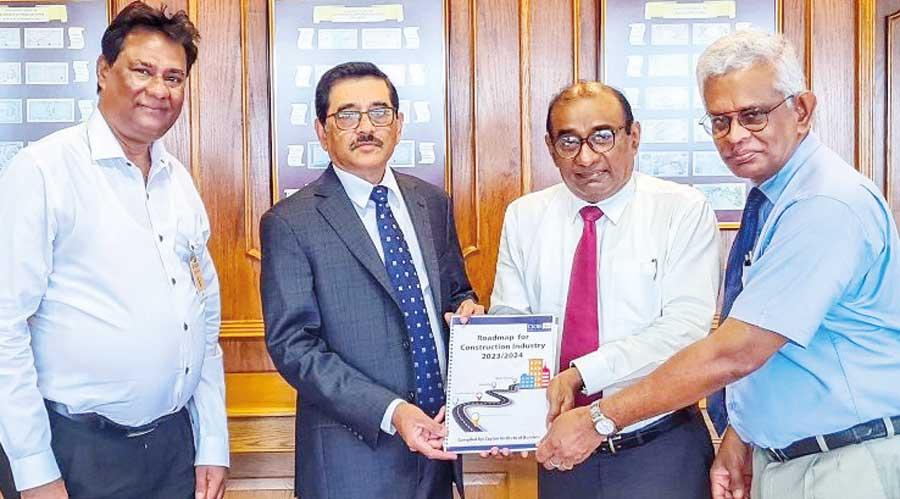29 Mar 2023 - {{hitsCtrl.values.hits}}

CIOB President Dr. Rohan Karunaratne presenting the construction roadmap to Central Bank Governor Dr. Nandalal Weerasinghe
- Road map formulated by CIOB contains 30-point action plan
- Highlights need for soft loans to contractors to service existing loans
- Urges CB to look at establishing an infrastructure development bank/fund
- If implemented, CIOB says construction sector can aim for 10% contribution to GDP
Stakeholders of the construction sector presented to the Central Bank this week a 30-point action plan that will help improve its contribution to the economy—to levels before the economic crisis severely hampered its performance.
The road map was formulated by the Ceylon Institute of Builders (CIOB) with the aim of “restarting” the construction sector for the year 2023/2024.
“If these points are strategically executed, the Sri Lankan construction industry can stand back and support the economy like never before and can aim for a 10 percent GDP contribution,” CIOB said in a statement to the media.
Prior to the economic crisis and the implications that stemmed from the pandemic, the local construction sector contributed to around 9.6 percent to the GDP. However, activities of the sector and the contribution to the GDP has fallen to a range below inflation, CIOB pointed out.
Some of the concerns raised in the road map include settlement of dues, settling industry issues with banks, re-commencing halted projects, imposing liquidated damages, encouraging funding agencies to provide a soft loan to the industry, establishing an infrastructure development bank/fund, and the calculation of construction inflation index, among others. In the road map, CIOB has highlighted four key areas for Central Bank’s attention.
The first is to provide soft loans to contractors to service existing loans, partly, so that their credibility can be re-established. Such provisions will provide them with the ability to restructure their loans, CIOB said.
The second is to identify the most value-added projects to the country which are still underway and ensure their completion. This should be done via a task-force including stakeholders from the private sector, CIOB said.
The third area of concern is to retain and certify skilled workers so that they can secure overseas employment. According to CIOB, efforts should be made to provide relief to unemployed construction workers, and retrain them with an internationally accepted certification by CIOB academy (TRACS) so that subsequent foreign employment could be secured.
Lastly, the Central Bank was urged to look at establishing an infrastructure development bank/fund to facilitate financial needs of the construction industry.
“An Infrastructure development bank/fund could absorb low-cost funding relieving weight on the government. Such a fund could be funded by GOSL, banks- government/private, contractors, local investors, and low-cost foreign funding,” the CIOB said.
Due to the stoppage of construction and non-payment to contractors, the local construction sector is currently in an almost stagnant state.
The reduced activity has led to the unemployment of 650,000 direct workers (many being from the poorest classes of society) and copious small, medium and large contractors to face bankruptcy, which includes over 4,000 SME sector contractors, and about 50 major contractors have reached standstill., CIOB noted.
23 Dec 2024 3 hours ago
23 Dec 2024 4 hours ago
23 Dec 2024 4 hours ago
23 Dec 2024 5 hours ago
23 Dec 2024 6 hours ago